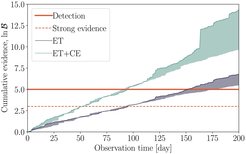Probing the boundaries of spacetime
Using the gravitational-wave memory for a new test of general relativity and to reveal fundamental spacetime symmetries
Gravitational waves are now routinely observed from the inspirals and mergers of black holes and neutron stars. According to general relativity, they are expected to leave a permanent deformation of spacetime following their passage. Although not yet observed, this deformation, known as “gravitational-wave memory”, has previously been shown to represent fundamental symmetries that govern asymptotic boundaries of spacetime. In this study, an international team led by a scientist at the Max Planck Institute for Gravitational Physics in Hannover proposes to use this correspondence to probe spacetime symmetries directly with observations of the gravitational-wave memory. They show how current and future gravitational-wave observatories, such as LISA, the Einstein Telescope, and Cosmic Explorer, may reveal the hierarchy of potential memory signatures and the corresponding symmetries. This novel test of general relativity may potentially lead to new insights into the interplay between gravity and quantum mechanics. In addition, the detection of gravitational-wave memory could help to infer the properties of the “loudest” compact binary merger signals, such as their distance and position in the sky, more accurately than previously thought.
Paper abstract
We revisit gravitational wave (GW) memory as the key to measuring spacetime symmetries, extending beyond its traditional role in GW searches. In particular, we show how these symmetries may be probed via displacement and spin memory observations, respectively. We further find that the Einstein Telescope's (ET) sensitivity enables constraining the strain amplitude of a displacement memory to 2% and that of spin memory to 22%. Finally, we point out that neglecting memory could lead to an overestimation of measurement uncertainties for parameters of binary black hole (BBH) mergers by about 10% in ET.













